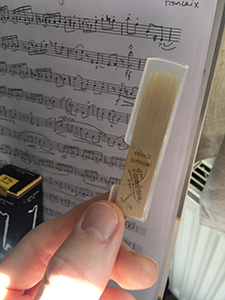
The reed box, where (supposedly) all the best ones live
Fewer words strike equal amounts of fear and frustration into the heart of wind players than the word ‘reed’. This seemingly simple piece of cane we attach to our mouthpiece can be the make or break between a beautiful sound and a simple squawk.
Clarinettists and saxophonists use a single reed, so named because of the single piece of cane that is fixed to their mouthpiece with a ligature. Oboists and bassoonists have to contend with double reeds, fashioned out of two thinner canes tied together which give that, er, ‘lovely’ sound when blown together. What I do know for sure is that we as clarinettists are lucky, in that we can buy boxes of pre-manufactured reeds that normally do the job. Double reed players have to make their own from scratch, leading to many hours of tedium and despair. I’ve been reliably informed that gin and daytime TV are two common accompaniments to reed-making – often simultaneously.
When you hear a beautiful clarinet solo soaring over the orchestra in a concert, you never think about the hours that have gone into trying out reed after reed to get the one that sings. What complicates matters even further is that reeds are sensitive: they’re made from cane, an organic material, and as with any organic material they react to changes in temperature, humidity, how loudly you play them, what colour socks you’re wearing that day… the list goes on. What this boils down to is one reed sounding great in one room on a certain day, but then the next day, in a different place, it could be awful.
Rachmaninoff: Symphony No. 2 in E Minor, Op. 27 – III. Adagio (London Symphony Orchestra; Valery Gergiev, cond.)

Ah, the mysterious tick mark… when was it made? Where does it come from?
Why doesn’t it work any more?
Most players will have an array of reeds to hand, ranging in strength, to hopefully provide a good enough selection that one can be chosen to fit the bill at any one time. At times, it can be hard to survive in a world where you’re expected to always make a beautiful sound but your gear can often far from deliver. It is in this space, between the expectation of others and the reality of what is in front of you, that a lot of stress lies.
Broadly speaking, you have to be ready for any situation, and should have a ready-to-play reed always on hand. I even went to the dark side and bought a synthetic reed, made from polypropylene – the theory being that they react far less to changes of humidity, temperature, socks and so on – and while it can help in a really desperate situation, I couldn’t quite get the same sound quality as on cane, so I try to use cane as much as possible.
Every player has their system. I try my best to stay on top of my reeds; on good days, I know exactly what is in my box, when I tried it and what to expect when it’s on the mouthpiece. On bad days, all I see is a jumble of cane sticks as I sit blindly grasping any reed that seems to not be about to disintegrate in my clammy hands. Ok, perhaps I’m exaggerating a little, but in the heat of the moment, if your reed gives up on you, this is how it can feel.

The reed drawer – fairly organised (chaos)
Does the perfect reed exist? Personally, I don’t think so. If it did I wouldn’t be writing this. I’m much more in the mindset of ‘make what you have work’ rather than fretting too much. Every instrument has its annoying quirks: brass instruments have oil and valves, string instruments have bows and, well, strings; pianists have to play an entirely new instrument in each new venue.
There will be some out there who claim reeds are more of a hassle than these other things, and, well, I would tend to agree, although I couldn’t be sure if it wasn’t just my institutional bias speaking. The best we can do is grin and bear it. There will be good days, there will be bad days, but the more we play and learn, the more we will discover, and we can be evermore ready to adjust at the drop of a hat.



